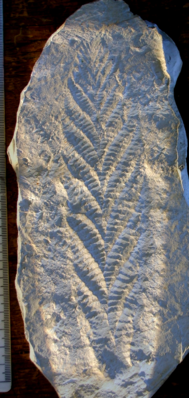Rangeomorpha
| Rangeomorpha | ||||||||
|---|---|---|---|---|---|---|---|---|

|
||||||||
| Temporal occurrence | ||||||||
| Ediacarium | ||||||||
| 635 to 541 million years | ||||||||
| Locations | ||||||||
|
||||||||
| Systematics | ||||||||
|
||||||||
| Scientific name | ||||||||
| Rangeomorpha | ||||||||
| Plow , 1972 | ||||||||
The Rangeomorpha are a group of creatures from the Ediacarian , the highest period of the Proterozoic . With an age of 575 to 560 million years, they are among the oldest representatives of the Ediacaran fauna . Fossils of the group are best known from Mistaken Point on the Avalon Peninsula on the Canadian island of Newfoundland , but also from other places on earth. The best-known genera include the bush-like Bradgatia from England, the Charnia and Charniodiscus , which resemble a fern leaf, and the lobed Ivesia and Rangea .
features
The Rangeomorpha were sessile creatures that could reach sizes in the lower decimeter range, resembled fern leaves or three-dimensional bushes in most cases and were usually attached to the sea floor with an adhesive disk. The largest form, Charnia could reach a height of one meter. The growth of the Rangeomorpha is fractal-like , ie the side branches branching off a central axis showed a remarkable self-similarity or high scale invariance to the central axis, as did the side branches to their side branches. Kevin J. Peterson and colleagues hypothesized that the Rangeomorpha, like mushroom mycelium, consumed food over their entire surface. They were probably capable of vegetative reproduction . Thread-like runners, typically 100 to 1,000 micrometers thick and two to 40 centimeters long, which connected the individual “bushes” to one another, could have been used for reproduction or the exchange of nutrients.
There were spindle-shaped Rangeomorpha that lay on the seabed, and bush-shaped, plume-shaped, comb-shaped and frond-shaped ones that held on with an adhesive disc. They dominated the ecosystems of the early Ediacarium, when there were probably no or hardly any mobile or burrowing creatures. In the younger strata of the Ediacarium, they appeared only rarely, perhaps as a result of competition with mobile animals such as Kimberella or Yorgia . B. in Burgess slate completely.
The Rangeomorpha likely form a monophyletic group, that is, a community of descent that includes a common ancestor and all of his descendants. They are probably not closely related to any modern group of living beings and represent a submerged form of multicellular life. According to Kevin J. Peterson and colleagues, however, they could be the main group representatives of the fungi (Fungi) or at least be closer to the fungi than to the multicellular animals (Metazoa).
literature
- Guy M. Narbonne (Aug 2004). Modular Construction of Early Ediacaran Complex Life Forms . Science , Volume 305, Pages 1141-1144, doi: 10.1126 / science.1099727
- Kevin J. Peterson, Ben Wagoner, James W. Hagadorn (2003). A Fungal Analog for Newfoundland Ediacaran Fossils? Integrative and Comparative Biology, Volume 43, Pages 127-136, PDF
supporting documents
- ^ Liu and Dunn: Filamentous Connections between Ediacaran Fronds. Current Biology (2020), doi: 10.1016 / j.cub.2020.01.052